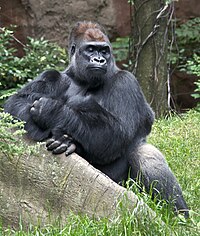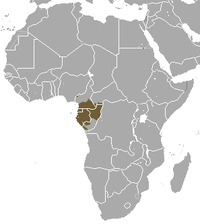|
Vikidia currently has 4,621 articles. Improve it! |
|
Join Vikidia: create your account now and improve it! |
Western gorilla
|
|
You're reading a star article
Western gorilla isn't the only star article → Find more of them! |
The western gorilla (Gorilla gorilla) and the eastern gorilla (Gorilla beringei) are the only two species of gorilla. There are two subspecies of the western gorilla: the western lowland gorilla (Gorilla gorilla gorilla) and the Cross River gorilla (Gorilla gorilla diehli). There are differences in the skull and tooth dimensions of the two subspecies.
In 2014, the western lowland gorilla numbered perhaps 125,000 while the Cross River gorilla numbered perhaps 250. The two subspecies are endangered.
Description[edit | edit source]
Western gorillas are usually brown or greyish with a yellowish forehead. These gorillas have an overhanging tip on their nose that is absent in eastern gorillas.
In the wild, mature males average 155 cm (61 in) in height while mature females average 135 cm (53 in). Captive western gorillas average 157 kg (350 lb) in males and 80 kg (180 lb) in females.
Lifestyle[edit | edit source]
Western gorillas live in rainforests in groups that may number between 2 and 20 individuals. Each group has 1 male, several females and their babies. Males leave the group when they reach sexual maturity.
A group of gorillas is called a "troop". The male leader of the troop is called a silverback, after the coloring on his back.
Gorillas have long lives. They may live for as long as 40 years in the wild. A group's home range may be as large as 30 square km. Gorillas do not actively defend their living spaces. Wild western gorillas use tools.
Offspring[edit | edit source]
Females begin breeding at age 8 or 9. Female gorillas give birth to one infant after a pregnancy of nearly 9 months. Newborns weigh about 2 kg (4 lbs).
Babies cling to their mother's fur. They ride on their mothers' backs from the age of four months through the first two or three years of their lives.
Young gorillas aged three to six years old are much like human children. They play, climb trees, chase each other, and swing from branches.
Mothers care for their babies about the first 3 or 4 years of its life. Because of these long time spans, a female will give birth only every 6 to 8 years.
Diet[edit | edit source]
The western gorilla's diet consists mostly of fruits. When fruit is scarce, the western gorilla eats twigs and leaves. Termites and ants, caterpillars, grubs, and larvae are also sometimes eaten. They enjoy the effect of caffeine in the Cola seeds they eat.
Conservation[edit | edit source]
The World Conservation Union lists the western gorilla as critically endangered. The ebola virus has depleted the species in some areas, with little likelihood of recovery.
Human developments such as farming and lumbering, poaching, and civil wars are diminishing the western gorilla's living spaces. Gorilla reproduction rates are low, making it difficult to restore population numbers.

|
Animals Portal — All articles about animals |

|
Endangered Species Portal — All articles about endangered species |



